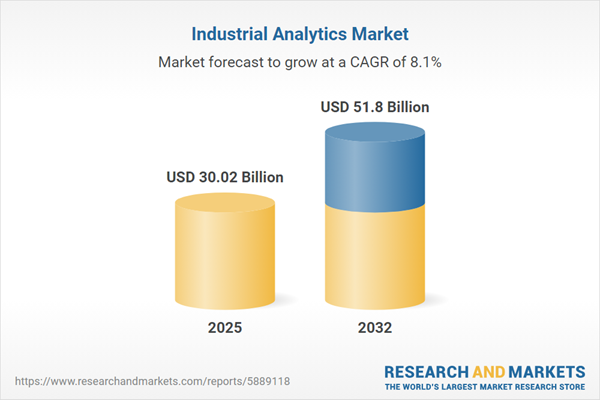Speak directly to the analyst to clarify any post sales queries you may have.
Industrial analytics is redefining decision-making for senior executives by integrating real-time operational intelligence across complex, data-rich industries. The strategic deployment of advanced analytics enables organizations to anticipate changes, optimize resources, and sustain competitive momentum in today’s digital era.
Market Snapshot: Industrial Analytics Market Growth & Trends
The Industrial Analytics Market is poised for steady advancement, reaching USD 27.74 billion in 2024 with a forecasted value of USD 30.02 billion by 2025. Expecting a compound annual growth rate (CAGR) of 8.11% through 2032, future projections indicate a market worth USD 51.80 billion. This growth is anchored by organizations moving toward digital transformation, embedding analytics deeper within business models, and elevating operational efficiency. High adoption rates span core sectors such as manufacturing, healthcare, utilities, energy, transportation, and services. As analytics investment continues, companies are prioritizing adaptive digital strategies and robust value generation, shaping a market landscape characterized by innovation and evolving requirements.
Scope & Segmentation: Strategic Industrial Analytics Insights
- Component: Encompasses a mix of services—including consulting, integration, and ongoing support—along with software covering advanced analytics, business intelligence, data visualization, and management.
- Analytics Type: Solutions span descriptive analytics for trend and pattern identification, predictive analytics for forward-looking insights, and prescriptive analytics for actionable recommendations.
- Deployment Model: Includes cloud-based architectures (public, private, hybrid) and on-premises implementations to address agility, security, or compliance needs.
- Organization Size: Serves large enterprises and small to midsize businesses, scaling to meet diverse operational demands and levels of digital maturity.
- Application: Ranges from asset optimization, predictive maintenance, and energy management to quality analytics, safety compliance, resource allocation, and supply chain oversight.
- Industry Vertical: Widely adopted by chemicals, energy, utilities, healthcare, life sciences, manufacturing, oil and gas, and logistics sectors, each seeking data-driven performance and regulatory alignment.
- Regions: Addresses dynamics in the Americas, Europe, Middle East, Africa, and Asia-Pacific, recognizing diverse technology readiness and adoption across global markets.
- Leading Companies: Includes Microsoft Corporation, International Business Machines Corporation, General Electric Company, SAP SE, Siemens AG, PTC Inc., Honeywell International Inc., Rockwell Automation Inc., Oracle Corporation, and Hitachi Vantara LLC, all driving innovation and product evolution in industrial analytics.
Key Takeaways for Senior Decision-Makers
- Adopting industrial analytics streamlines processes, supports proactive decision-making, and embeds sensor-driven intelligence for measurable operational improvements.
- Utilization of edge computing and real-time data processing reinforces agility and empowers rapid, informed responses to dynamic business needs.
- Collaboration between solution providers and equipment manufacturers ensures smooth integration with existing and new infrastructure, reducing risk during technological shifts.
- Integrating analytics within sustainability and compliance initiatives allows organizations to track energy use, manage environmental metrics, and fulfill regulatory obligations.
- Enhancing workforce data literacy and fostering a culture of analytics supports ongoing value realization and technology-driven adaptability.
- Tailored rollout strategies, aligned with local regulations and customer expectations, drive success in varied regional markets.
Tariff Impact: Navigating Regulatory and Market Dynamics
Recent United States tariff adjustments are influencing procurement and technology approaches within the industrial analytics sector. Rising hardware import expenses motivate organizations to transition toward cloud-based analytics, controlling capital outlays amid global supply uncertainties. Companies are prioritizing localized analytics services, targeted workforce training, and flexible sourcing to ensure ongoing regulatory compliance and robust operational continuity in a changing market landscape.
Methodology & Data Sources
This overview draws on methodical secondary research from industry literature, technical regulations, and published data. It is augmented by executive interviews and quantitative surveys, ensuring validated and strategic insight into industrial analytics market direction.
Why This Report Matters
- Supports senior leaders in benchmarking digital transformation roadmaps and charting progress along the analytics maturity curve.
- Assists IT and operations executives in choosing technologies, shaping deployment plans, and navigating risk with segmented market intelligence.
- Delivers actionable perspectives on regulation, innovation, and sustainability factors shaping industrial analytics trajectories.
Conclusion
Industrial analytics stands as an essential tool for driving adaptability, efficiency, and responsible growth. This analysis equips decision-makers to make sound technology investments and achieve measurable enterprise progress.
Additional Product Information:
- Purchase of this report includes 1 year online access with quarterly updates.
- This report can be updated on request. Please contact our Customer Experience team using the Ask a Question widget on our website.
Table of Contents
3. Executive Summary
4. Market Overview
7. Cumulative Impact of Artificial Intelligence 2025
List of Figures
Samples

LOADING...
Companies Mentioned
The key companies profiled in this Industrial Analytics market report include:- Microsoft Corporation
- International Business Machines Corporation
- General Electric Company
- SAP SE
- Siemens AG
- PTC Inc.
- Honeywell International Inc.
- Rockwell Automation, Inc.
- Oracle Corporation
- Hitachi Vantara LLC
Table Information
| Report Attribute | Details |
|---|---|
| No. of Pages | 185 |
| Published | October 2025 |
| Forecast Period | 2025 - 2032 |
| Estimated Market Value ( USD | $ 30.02 Billion |
| Forecasted Market Value ( USD | $ 51.8 Billion |
| Compound Annual Growth Rate | 8.1% |
| Regions Covered | Global |
| No. of Companies Mentioned | 11 |









